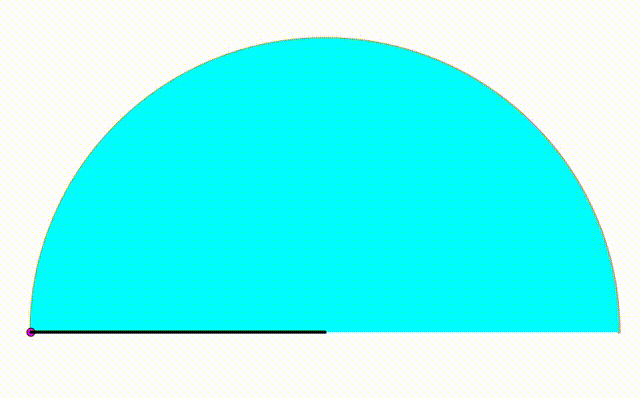Dynamic Geometry: P80
 The diagram shows an orange semicircle with radius
. The cyan and green semicircle are growing and shrinking freely on the black semicirle's diameter. The pink circle is internally tangent to the black semicircle and tangent to both green and cyan semicircle. Using their three centers, we draw a black triangle. When the ratio of its area to its perimeter is equal to
, the ratio of the larger semicircle's radius to the radius of the smaller semicircle can be expressed as
, where
and
are coprime positive integers. Find
.
The diagram shows an orange semicircle with radius
. The cyan and green semicircle are growing and shrinking freely on the black semicirle's diameter. The pink circle is internally tangent to the black semicircle and tangent to both green and cyan semicircle. Using their three centers, we draw a black triangle. When the ratio of its area to its perimeter is equal to
, the ratio of the larger semicircle's radius to the radius of the smaller semicircle can be expressed as
, where
and
are coprime positive integers. Find
.
The answer is 19.
This section requires Javascript.
You are seeing this because something didn't load right. We suggest you, (a) try
refreshing the page, (b) enabling javascript if it is disabled on your browser and,
finally, (c)
loading the
non-javascript version of this page
. We're sorry about the hassle.
Let the centers of the unit, green, and cyan semicircles, and the pink circle be O , A , B , and C respectively; the radii of the green and cyan semicircles, and the pink circle be r 1 , r 2 , and r respectively; ∠ C O B = θ : and C N be perpendicular to A B . We note that
r + r csc θ r = 1 = 1 + csc θ 1 = 1 + 2 t 1 + t 2 1 = ( 1 + t ) 2 2 t Let t = tan 2 θ
By Pythagorean theorem ,
A C 2 − C N 2 ( r 1 + r ) 2 − r 2 r 1 2 + 2 r 1 r + r 2 − r 2 r 1 2 + 2 r 1 r ( 1 + t ) 2 4 t r 1 ⟹ r 1 = A N 2 = ( A O + O N ) 2 = ( 1 − r 1 + r cot θ ) 2 = ( 1 − r 1 + ( 1 + t ) 2 2 t ⋅ 2 t 1 − t 2 ) 2 = ( 1 + t 2 − r 1 ) 2 = ( 1 + t ) 2 4 − 1 + t 4 r 1 + r 1 2 = ( 1 + t ) 2 4 − 1 + t 4 r 1 = 1 + 2 t 1
Similarly, from B C 2 − C N 2 = B N 2 , we get r 2 = 2 + t t . When the ratio of the area to the perimeter is:
p A 2 8 A 2 8 ⋅ 2 A B ⋅ C N 1 4 ( 2 − r 1 − r 2 ) r 1 4 ( 2 − 1 + 2 t 1 − 2 + t t ) ( 1 + t ) 2 2 t 2 t 2 + 5 t + 2 1 4 t ( 2 t 2 + 8 t + 2 ) 2 8 t 6 t 2 − 1 3 t + 6 ( 3 t − 2 ) ( 2 t − 3 ) t = 2 8 3 = 3 p = 3 ( A B + B C + C A ) = 3 ( 2 + 2 r ) = 6 ( 1 + ( 1 + t ) 2 2 t ) = 3 ( t 2 + 4 t + 1 ) = 6 t 2 + 1 5 t + 6 = 0 = 0 = 3 2 , 2 3
Since the system is symmetrical about the y -axis, we can use either of the values of t . Let us use t = 3 2 ; then r 1 = 1 + 2 t 1 = 7 3 , r 2 = 2 + t t = 4 1 , and r 2 r 1 = 7 1 2 . Therefore p + q = 1 2 + 9 = 1 9 .